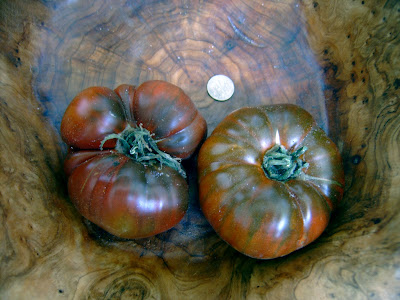Growing Purple Podded Pole Beans
This is my first year growing beans. And I can assure you it will not be the last! I've been so surprised by how well they have grown. I choose a variety "Purple Podded Pole Beans" from Reimer Seeds.

In the spring, I painted an old 7-foot trellis bright blue. As I was painting, I wondered, "Will the beans even grow even half this tall?" "Seven feet is pretty high!" But the package said "Pole Beans", so I stuck the trellis in the ground and secured it to the fence. The seeds went in at the beginning of the summer. It was agonizing waiting for them to sprout (it was probably only about 8 days in reality). But after that, they were off to the races! They quickly grew to the top of the 7-foot trellis and began to twist in the wind for several more feet over the top. I tried to wind them back in along the top of the trellis.

Then, flowers, lots of them; a pretty magenta-purple color. Next, baby beans, so cute. Don't you just love baby anything?

And finally, as the baby beans grew, they began to turn fully dark purple at about 6-7 inches long. After a couple of days, I had enough to make a meal for my husband and me. Yee-haw! I was so excited, that I selected some of my freshly dug Colorado Rose potatoes to go along with the beans. The Colorado Rose is a beautiful potato...a lovely rose-pink on the inside. As I was cooking along, I realized that we were going to have a meal of pink potatoes and purple beans! Just imagine that on a plate together. Weird! Maybe too weird...even for me! But in fact, the purple podded pole beans turn green as they cook and the pink potatoes lighten in color significantly. So, we had a light pink and green meal, instead. The most important thing is that it tasted great!
Since the initial sowing of the PPP beans, I have picked over 7 lbs from a single 6 foot row. The first picking session occurred on July 17 and now, by August 22, they are finally starting to slow down in production. This is such a great vegetable for a small space. It only took up a 6 square feet of growing space and not only that, the plant is beautiful to look at. This is typically important for micro-veg gardeners, who grow right outside their back doors. Not everyone has the luxury of "the back 40".
I have also compared the growth of the Purple Podded Pole Beans to that of Painted Lady Runner Beans and Scarlet Runner Beans. I planted both types of runner beans in early June and they have grown so SLOWLY. They have beautiful flowers, but they haven't reached the top of their 7-foot trellis and they just look kind of weak. To put it simply, they aren't "earning their keep"! About 2 weeks later at the very end of June, I planted another round of Purple Podded Pole Beans next to the runner beans. The purple beans have, again, taken off and are past the top of their 7-foot homemade trellis. Even though the PPP beans were planted later, they already have baby beans showing, while the runner beans limp along. Here's a picture of the PPP beans on a trellis made from plum tree stakes and garden twine.

I decided that the twine didn't have to be tied at right angles. It's a bit of an "art installation" ;)
So, PPP beans >>> runner beans (at least for me).
Canning the BeansI've picked so many beans that I had to can some. It's really simple to do if you have a pressure canner. Here's how I do it:
1) Wash the beans and line them up on a cutting board, all facing the same way.
2) Cut the "stem ends" off. Some people cut both ends off, but the tails don't bother me.

3) Cut them into sections and place in a jar to within 1" of the rim.

4) Pour boiling water over to top to within 1" of the rim.

5) Place a lid on top and a screw cap ring.
6) Process in a pressure canner for 20 minutes at 10 lbs.
7) Save for winter, if you can make it that long :)
 Hmm...what's wrong with this picture? Do you regularly stand out in your garden and spray water into the air? I'm guessing not. The lady above seems to be spraying up into the air and over onto the gravel pathway. She's missing the plants!
Hmm...what's wrong with this picture? Do you regularly stand out in your garden and spray water into the air? I'm guessing not. The lady above seems to be spraying up into the air and over onto the gravel pathway. She's missing the plants!
















































